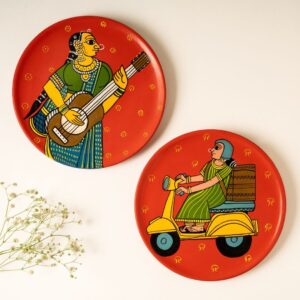If you ever walk into Sai Kiran Dhanalakota’s home in Hyderabad, the first thing you notice is the colour. Brushes, half-finished scrolls, wooden masks drying in the sun — all part of a fading world that his family has kept alive for generations. Cheriyal painting isn’t just an art form here; it’s how stories were once told. Before cinema, before books in every hand, wandering storytellers would carry long painted scrolls made by families like his, singing epics from one village to another.
 Sai Kiran grew up watching his parents mix tamarind seed paste and white mud to prepare cloth for the scrolls. No canvas, no factory colours. The cotton is coated, dried, coated again, and only then does the drawing begin — strong black outlines, then vivid reds, blues and greens made from natural pigments. Every figure has wide eyes and rounded faces, every scene crammed with life — gods, farmers, animals, brides on palanquins.
Sai Kiran grew up watching his parents mix tamarind seed paste and white mud to prepare cloth for the scrolls. No canvas, no factory colours. The cotton is coated, dried, coated again, and only then does the drawing begin — strong black outlines, then vivid reds, blues and greens made from natural pigments. Every figure has wide eyes and rounded faces, every scene crammed with life — gods, farmers, animals, brides on palanquins.
After the traveling scrolls were replaced by other items that told stories: boxes (and now panels, ironically), the art moved to different mediums: as masks, art plates, on products, on canvas, and on cloth.
With Club Artizen, Sai Kiran and his family have experimented with different products reflecting the ethos of sustainability. Old, unwanted CDs became tealight holders with Cheriyal figures dancing around the flame. Coasters with mythological characters and village scenes found their way to city homes. And then came the playful series — a Cheriyal woman riding a scooter, and playing the guitar. Still the same big eyes, still the same red background, but living in today’s world.

